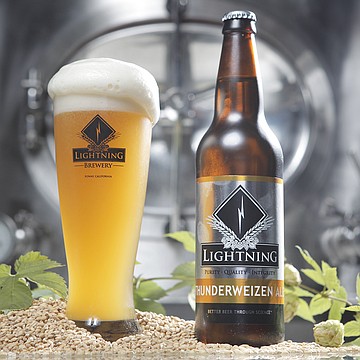 Facebook
Facebook
 X
X
 Instagram
Instagram
 TikTok
TikTok
 Youtube
Youtube
Remember when hefeweizens were as ubiquitous as IPAs are today and amber/red ales were back in the nineties? Whether it was craft beer or even the macro big boys, nearly everybody had a Germanic wheat beer to offer. Yet, a survey of our county, which now boasts over 60 breweries, turns up very few hefeweizens. What happened? I can venture an educated guess.
Hefeweizens were popular early in the microbrew days because they weren’t that far removed from the flabby macrolagers that were pretty much all Americans knew of beer. It was easy to make a jump from those to similarly light-bodied, heady, refreshing brews where the only discernible difference was the presence of light banana and clove flavors. Then San Diego’s first wave of hop-forward brewers began introducing the game-changing India pale ales and double IPAs that would become San Diego’s signature creations. Early craft beer drinkers fell in love with them and local palates became attuned to big, bold flavors and higher alcohol styles, leaving little demand for low ABV wheat beers.
Hefs fell out of favor. Most San Diego wheat beers produced in this millennium have been Belgian witbiers, better known as wits. But hefeweizen never went away completely. The style was mostly available at brewpubs, which tend to adhere to the restaurant model of offering a little something for every palate out there. But there’s one local brewery that, from day one, led with a hefeweizen. That operation is Lightning Brewery (13200 Kirkham Way. Poway).

Run by scientist-turned-brewer Jim Crute, the North County operation specializes in beer styles that are less prominent in our area—pilsner, dopplebock, winter warmer, and hefeweizen. For years, his Thunderweizen, has been the best locally produced hef and Lightning’s best-selling beer. It bursts with clove-like spiciness and has good banana fruitiness without coming across like a sickly sweet ice cream parlor dessert. It’s a bit more substantial in body than most thin and bubbly hefeweizens, which helps imbibers get over the withdrawal of opting for it over a pale or amber ale.
That mouthfeel is the result of double decoction brewing. Crute takes a fraction of the mash, boils it and adds it back to the bulk to raise the overall temperature, lending more body to the finished product. He also ferments Thunderweizen horizontally in the manner of major German breweries. This increases surface area for bad-tasting foam proteins to adhere to when the beer is fermenting. Lastly, he allows the beer to age at room temperature and lager before releasing it.
There’s a lot of passion to produce something modern yet traditional where Thunderweizen is concerned, and that comes through in the beer’s ample flavor. If you haven’t had a hef in a while, this is the one to reach for when reacquainting yourself with the style.

Remember when hefeweizens were as ubiquitous as IPAs are today and amber/red ales were back in the nineties? Whether it was craft beer or even the macro big boys, nearly everybody had a Germanic wheat beer to offer. Yet, a survey of our county, which now boasts over 60 breweries, turns up very few hefeweizens. What happened? I can venture an educated guess.
Hefeweizens were popular early in the microbrew days because they weren’t that far removed from the flabby macrolagers that were pretty much all Americans knew of beer. It was easy to make a jump from those to similarly light-bodied, heady, refreshing brews where the only discernible difference was the presence of light banana and clove flavors. Then San Diego’s first wave of hop-forward brewers began introducing the game-changing India pale ales and double IPAs that would become San Diego’s signature creations. Early craft beer drinkers fell in love with them and local palates became attuned to big, bold flavors and higher alcohol styles, leaving little demand for low ABV wheat beers.
Hefs fell out of favor. Most San Diego wheat beers produced in this millennium have been Belgian witbiers, better known as wits. But hefeweizen never went away completely. The style was mostly available at brewpubs, which tend to adhere to the restaurant model of offering a little something for every palate out there. But there’s one local brewery that, from day one, led with a hefeweizen. That operation is Lightning Brewery (13200 Kirkham Way. Poway).

Run by scientist-turned-brewer Jim Crute, the North County operation specializes in beer styles that are less prominent in our area—pilsner, dopplebock, winter warmer, and hefeweizen. For years, his Thunderweizen, has been the best locally produced hef and Lightning’s best-selling beer. It bursts with clove-like spiciness and has good banana fruitiness without coming across like a sickly sweet ice cream parlor dessert. It’s a bit more substantial in body than most thin and bubbly hefeweizens, which helps imbibers get over the withdrawal of opting for it over a pale or amber ale.
That mouthfeel is the result of double decoction brewing. Crute takes a fraction of the mash, boils it and adds it back to the bulk to raise the overall temperature, lending more body to the finished product. He also ferments Thunderweizen horizontally in the manner of major German breweries. This increases surface area for bad-tasting foam proteins to adhere to when the beer is fermenting. Lastly, he allows the beer to age at room temperature and lager before releasing it.
There’s a lot of passion to produce something modern yet traditional where Thunderweizen is concerned, and that comes through in the beer’s ample flavor. If you haven’t had a hef in a while, this is the one to reach for when reacquainting yourself with the style.
Comments